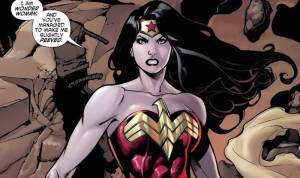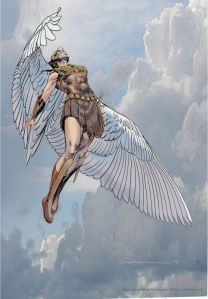What I have to say this week applies not only to comics but to writing in general. A couple of weeks ago, I lamented negative portrayals of women and children in graphic novels and used early issues of Wonder Woman to exemplify my arguments. While it might seem irrelevant to get upset about something that is obviously dated and silly in retrospect, I deliberately used images that would seem tame or even harmless. To be honest, some of the more current images are so graphic that I felt it would have been in bad taste to include them in my post. I contend that the points I made are valid, and using seemingly inoffensive examples might actually encourage readers to take a more careful look at how they and the rest of society think. Fantasy isn’t real, but it has real consequences, good and bad. Keep in mind that Wonder Woman is often uncritically regarded as a feminist icon because she is a superhero and because she is a woman. It is good to read thoughtfully and to choose one’s heroes carefully.

Our modern mythology in western society is embodied primarily in movies, comics, and popular fiction. The key here is writing. For something to be seen, it first must be written. Our culture in general and fantasy entertainment in particular are saturated with damaging portrayals of women. Those of us who write have the opportunity and the responsibility to help reverse this trend. Compelling characters and stories can have tremendous influence on the attitudes of many people. I am not suggesting we write propaganda at the expense of story quality. This takes too low a view of our respective readerships. These are people who can and will think for themselves, but they will choose from available options. Let’s offer them something better.

It isn’t enough just to have lead characters who are female. This can lead us into an insipid numbers game which actually defeats our purpose and continues to feed the beast. We need to take a more qualitative look at what we are doing and why. The following comments are based on my own limited experience, so I would appreciate any additional insights you might care to contribute.
I have noticed some trends which have been lauded as steps in the right direction in fantasy writing. Most with which I am familiar simply involve the raising of awareness by describing unsettling societal issues and incorporating them into plot and character development. It is fairly easy to describe the mistreatment of women, somewhat harder to shed light on the internal suffering this causes them, and much more difficult to create solutions which can show us a way forward. For example, a plethora of female superheroes have been written with backstories of abuse and discrimination. If I can say anything about them as a group, it is that they are portrayed as damaged and often angry. Internal conflict is the base from which they combat evil, and they have a tendency to remain hurt, angry, and conflicted as they unsuccessfully try to exorcise their personal demons. In other words, they don’t often get better.
The challenge for fantasy writers, as I see it, is to begin with characters who are damaged and then make them believably whole. In doing this, care must be exercised to prevent the story from devolving into a predictable morality play. Some would argue that healthy characters aren’t as interesting, but I respectfully disagree. Would you rather have a conversation with a disturbed stranger or with one who is more balanced? Healthy characters can have as many, if not more, interesting facets to their personalities as those who are damaged. The trick, and it is not trivial, is to make them interesting in their damaged condition and then to make them even more interesting when they are whole. Then, of course, there is the type of female character who starts out from a good place and ends up in an even better one. These are relatively under-utilized roles in current fiction, and they represent considerable literary potential.
Folks (and especially guys), we don’t have to keep our female characters in chains. They can also be more fully clothed. Superheroines are good for more than ogling, DTR talks, catfights (and other girl-on-girl drama), sexual abuse, and even social statements. They and other female leads are deep wells with many unexplored possibilities. As in relationships with real women, we have only scratched the surface.





Very good analyses, and I agree completely! Thank you!
LikeLiked by 1 person
Thank you. I felt like somebody put a nickel in me, but it’s a topic that concerns me. Take care.
LikeLiked by 1 person
I agree that the way women are represented in fantasy definitely needs to be improved. i think that the reason why they were so negatively portrayed is because of the audience that writers were creating characters for. It was a very patriarchal society and women were relegated to nothing but eye candy and damsels who needed saving. I think there does need to be more female driven vehicles but simply having a female there isn’t enough.They need to be treated with the same respect and attentiveness that a male character would receive. Great post, really interesting and thought-provoking read.
LikeLiked by 1 person
It is good to hear from you again. I teach biology at a women’s college (can’t remember if I told you before), and I have three daughters. This is a topic which resonates with me. This culture’s treatment of women has bothered me for a long time (decades). Take care. I look forward to reading more of your posts.
LikeLike
Amen. I think some writers go for the angle of making characters believable. But I think we also see now the damaged characters as rather cliche. Injection of whole characters who make things more balanced.
When it comes to the way characters are addressed and what they physically look like, I think suddenly the whole angle of making things believable goes straight out the window…
LikeLiked by 1 person
Damaged people are real. So are healthy people. Our sense of reality must be balanced. Thank you for your comment. The last point is interesting and is something I haven’t thought of before.
LikeLiked by 1 person
I’m watching the current DC reboots of Wonder Woman, Supergirl, Batgirl, etc. with interest.
LikeLiked by 1 person
What I am most interested in at present is the Wonder Woman movie. I’d really like to see if they got this character right. Although I haven’t seen Batman vs. Superman (leery of the investment of time after reading the critiques), I did read that hers was the most compelling character.
LikeLiked by 1 person
There is a lot truth here. I also agree on the fact that sane characters can be as interesting. People think so simplistically sometimes it annoys me. There are many stereotypes in women today, but I think there is also a lot there to say about the stereotypes of men, which deserves to be said.
LikeLiked by 1 person
You’re right about male stereotypes. I do think, however, that male characters seem to get a more varied treatment in fantasy literature, comics, and movies. I assume this reflects the consumer demographic, but things are slowly changing. Take care, and thanks for your comment.
LikeLike
Yes! Exactly. Can I like this twice?
LikeLiked by 1 person
If that is possible, I don’t mind. I hope more people end up reading this. Thank you so much.
LikeLike